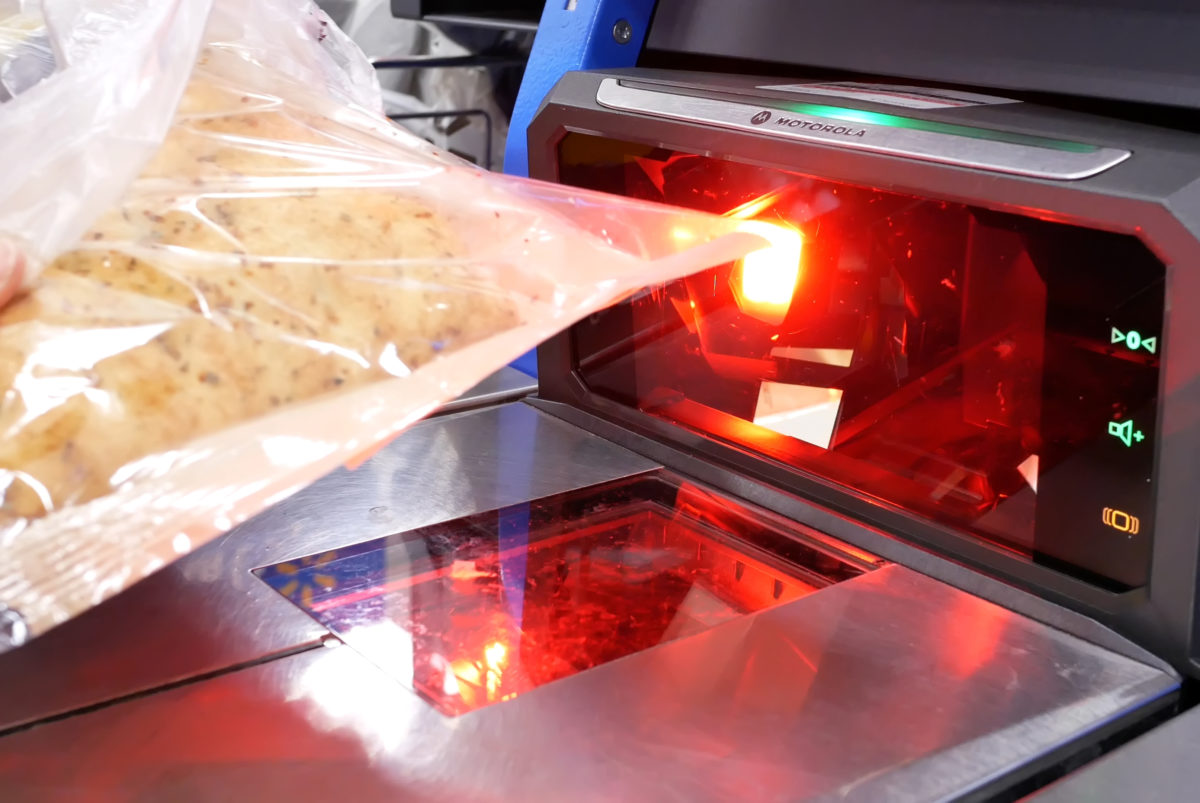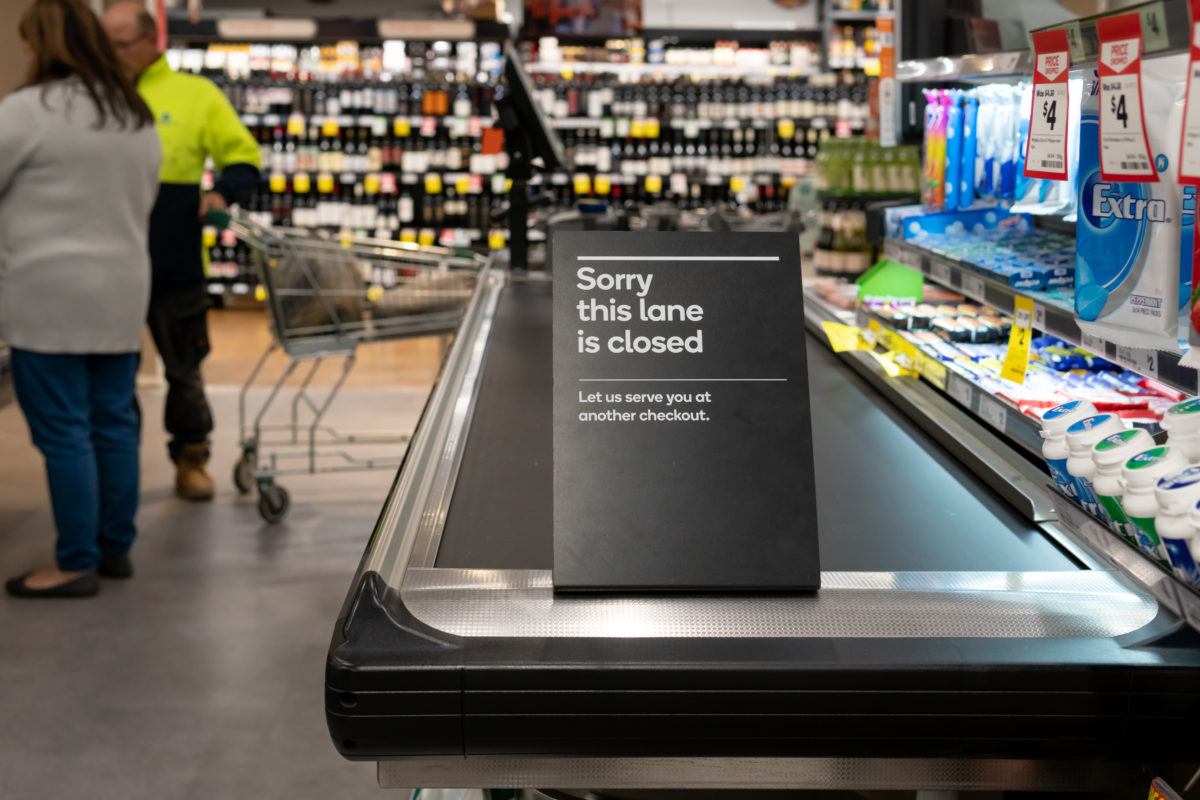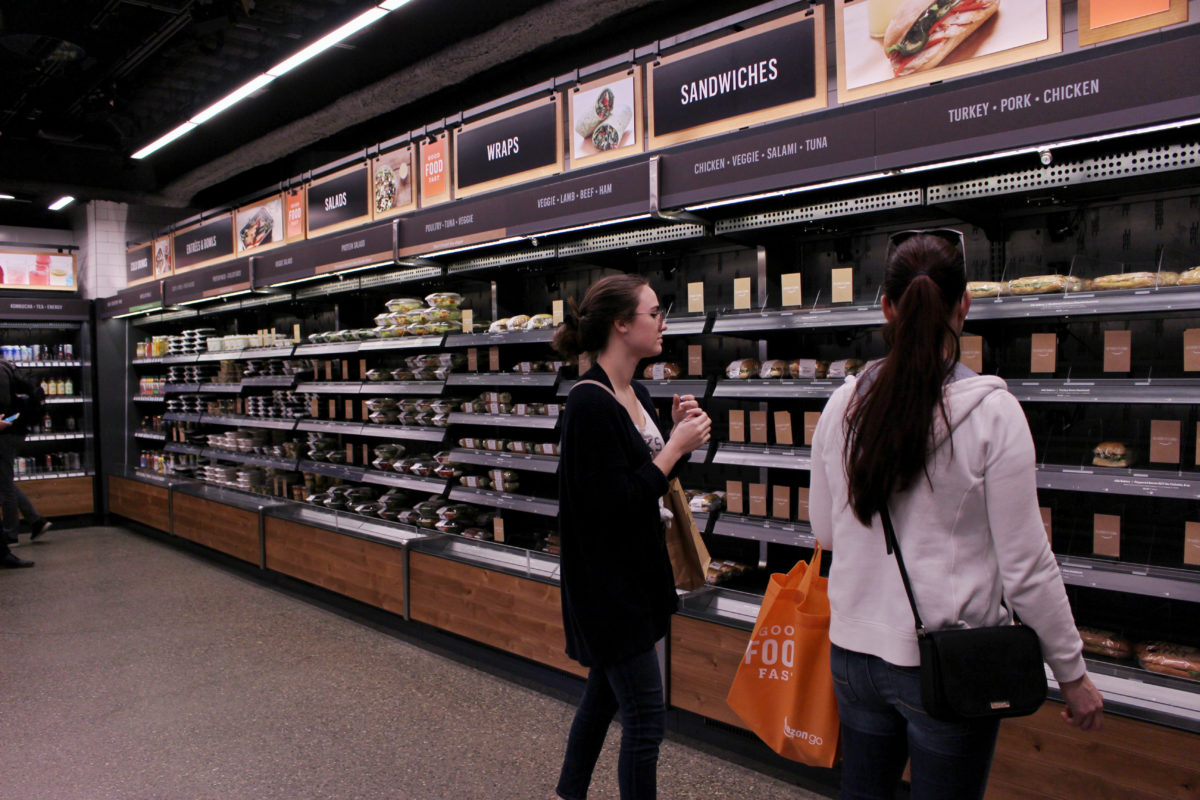The checkout queue was taking forever that day in a South Florida grocery store. David R. Humble, president of an electronics company, was among those in the long queue. The service clerk scanning goods in slow motion only intensified the experience. At least, this was probably how it seemed to the man standing in front of Humble, who lost his cool, grabbed the scanner from the clerk and began scanning the items himself.
This got Humble thinking – why couldn’t the customers scan their own items, thus eliminating all queues?
This is how the self-service checkout
was born in the 1980s. David R. Humble convinced the top-level management of his company, developed the first prototype and became the president of CheckRobot in 1984. According to
NewsOK
, developing a working self-service checkout took three years and five million dollars. The first self-service checkout machines then called automated checkout machines or ACM, were set up in a Kroger store in Atlanta in July 1986. One of the hottest innovations in retail had been born.
A Challenge to Engineers
The engineers tasked with creating the first self-service checkout faced a tremendous challenge. The first CheckRobot machine looked like a huge box with a conveyor belt, not too dissimilar from an airport luggage scanner.
Scanning the items was simple enough, but the machine also had to detect loose items that have to be weighed and fraud at the checkout. The device had to detect when a customer attempted to bag a bottle of expensive wine instead of the scanned bananas.
CheckRobot opted for a solution that used lasers to determine the measurements of the scanned item. If these matched the measurements in the database, the conveyor belt would move forward. If not, the belt would stop and reverse, and the entire process had to be repeated. One can only imagine how time-consuming this must have been and how frustrated the buyers felt.
CheckRobot’s competitors, including the current market leader, NCR, opted for a different solution – checking the weight of the scanned items. In essence, the customer had to place the scanned items on a packing area that was also a scale. The weight of the purchase had to match the data in the database. If the machine detected a discrepancy or the scanned item was not placed on the packing area, the system notified the store’s staff.
What is a Self-Service Checkout?
A self-service checkout, i.e. self-scanning, i.e. self-checkout
is an automated system that allows a customer to scan, pack and pay for the items they’ve selected without requiring the help of a service clerk. Instead, the buyer uses a touch-screen to communicate with a computer.When the
payment
is made (cash or card, depending on the system), the self-checkout will deactivate the goods’ security codes and the buyer can exit the store without triggering the alarm. In essence, you can enter, browse and exit the store without having to communicate with anybody.
Self-service trade was actually nothing new when it appeared in the 1980s. After all, it was relatively common to buy soda, cigarettes, and sweets from a vending machine. Supposedly it was engineer Heron who set up the first vending machine in his hometown Alexandria in Ancient Greece in the first century AD. His vending machine dispensed holy water in exchange for a coin.
Tobacco vending machines made from brass appeared in British taverns in the 1600s.
Contemporary vending machines began popping up on both sides of the Atlantic in the 1880s. People quickly adopted the innovation and soon vending machines could be used to buy anything from cigarettes to postcards. The most common lunch option in Philadelphia in 1902 was mac and cheese and boiled beans, as those were the dishes available in the first food vending machine in the area.
However, customers were more reluctant to adopt the changes in actual shops. When Tennessee shopkeeper Clarence Saunders opened his first shop where people could personally pick up goods from the shelves and put them in a basket in 1916, he was met with ridicule and reproval. People preferred to hand a shopping list to the shopkeeper and wait while the items were assembled for them. Although Saunders managed to quickly grow his self-service store chain, it took decades before self-service stores became the accepted mainstream in retail.
Fears and Opposition
The self-checkout has also faced a bumpy road to success, and not only in the 1980s, but even now, nearly four decades later. This is primarily caused by the customers’ fear of the unknown and the merchants’ opposition (large administrative expenses and risk of theft).
A survey conducted by Dalhousie University
in Canada in 2018
revealed that only 11% of shoppers regularly use self-checkouts.
People were afraid that something would go wrong and they’d be required to wait a long time; that you can’t scan items and take care of a baby at the same time; that the technical innovation will rob service clerks of their jobs; that it is inherently unacceptable that the buyer has to do the service clerk’s job without getting anything in return.
The organizers of the survey believe that the lukewarm interest is caused by average tech. On the one hand, the system is prone to errors and there’s nothing that shoppers hate more than the annoying “Unexpected item in the bagging area” prompt. On the other hand, it’s easy to accidentally miss an item and get into unwanted trouble at the store.

Granted, the technology was pretty helpless when it first appeared. NCR admitted on the 20th anniversary of the self-service checkout
that the engineers of the 1980s and 1990s were primarily concentrated on the technical solutions and not so much on creating a pleasant purchase experience. The first self-service checkouts imitated the logic of an atm and were vastly different from contemporary devices. It’s no wonder then that customers didn’t like the self-service checkouts!
The first self-service checkouts were also far less able to deal with theft than their contemporary counterparts. According to the National Retail Foundation’s (NRF) magazine
Stores
, a survey by Leicester University in the United Kingdom revealed that customers that use self-service checkouts regularly fail to scan items. The survey monitored one million buyers who scanned six million items; 850,000 of the six million items, i.e. one-seventh of all purchases, were not scanned. Considering the low margins in retail, this amounts to a significant loss for the merchant.
Many of the one-seventh of unscanned items can be attributed to error but others are not scanned intentionally. It is speculated that a self-service checkout machine urges even those people to steal who would otherwise never consider it. On the other hand, it’s quite difficult for the merchant to determine whether the error was accidental or intentional. A buyer who accidentally failed to scan an item once might do it intentionally in the future. There are a number of schemes used to outwit self-service checkouts but nothing can beat a man who tried to “buy” a $984 plasma TV from Walmart in 2007 by sticking a $4.88 DVD price tag on it.
Stoplift Checkout Vision Systems, that provides security camera solutions claimed in 2012 that stores with self-service checkouts experience five times more shoplifting than stores with service clerks.
Self-Checkouts on the Brink of a Breakthrough
The
Global EPOS and Self-Checkout 2018
questionnaire conducted by survey company RPB revealed that 2016 and 2017 were the years that saw a breakthrough in the spread of self-service checkouts. American retail giants Walmart and Kroger adopted new systems and replaced old ones. A whopping 63,000 self-checkouts were introduced in 2017, half of these in the US.
A number of trends support the adoption of self-service checkouts. Minimum wage limits have increased in several Canadian provinces in recent years, also increasing labor costs and motivating many Canadian retail chains to adopt self-checkouts. In Japan, it’s the increasing labor shortage that has urged store chains to invest in self-checkouts. Lidl is experimenting with self-service checkouts in France, as are Dollarama in Canada and Poundland in the UK. By 2017, the number of stores with self-checkouts had risen to 450 even in the relatively conservative Germany. Just two years prior, the number fell short of 300. Pilot projects have also been introduced in Brazil and China, with the number of self-service checkouts tripling in those countries.
Pilot projects that allow customers to scan items using a smartphone are also on the rise; however, in 2018 Walmart hit the breaks on their Scan and Go smartphone pilot project that included one hundred stores. Carrefour in Poland is also testing out a smartphone based Scan&Go system in their thirty stores. New markets are consistently joining the trend – for example, a similar pilot project has been introduced in Indonesian stores.
The top-ranking manufacturer that holds a whopping 61% of the market is NCR, followed by Toshiba (21%) and Diebold Nixdorf (7%). These are followed by Fujitsu, Digi, etc.
RBR boldly forecasts that the number of self-checkouts used globally will reach 450,000 by 2023. Most forecasts haven’t come true, as the growth has so far been slower than anticipated. Maybe now is the time the self-service checkout truly reaches the masses?
Irreversible Changes
You don’t really need to be a prophet to claim that self-service checkouts
have come to stay. However, this realization has brought about a plethora of reactions.
Retail employee unions point out that stores intentionally direct customers to self-checkouts, keeping staffed checkouts empty. This will lead to cashiers losing their jobs.
With technology taking over many tasks, people without a college degree need to start figuring out what their next job is going to be.
Huffington Post
relates the prediction of the US Bureau of Labor Statistics that the number of cashiers will decrease by about 1%, i.e. approximately 30,000 people, in the US over the period of 2016 to 2026. This might not seem like a lot, but their forecast didn’t take into account the jump in the self-checkouts popularity in 2016 and 2017. Thus, there is a reason to believe that the number of unemployed cashiers will increase quicker than anticipated.
The reason why shoppers are accepting the self-checkout increasingly more is simple – it’s the only contemporary innovation that can reduce the length of queues. Privacy is another important factor – what you buy is nobody’s business.
Granted, a popular TV channel proved during their test that people make mistakes at the self-checkout and actually spend longer scanning the items than a cashier would. But if we draw parallels with online banking, it’s safe to say it takes some time to get used to new tech. We used to be able to talk about a handful of heavy users, but once critical mass is achieved, the tech will reach the masses.
The store also benefits from this development – the buyers do the cashiers’ work and now one employee is enough to manage 6–8 if not more self-checkouts (removing the alcohol restriction, helping customers, routine checks, etc.), helping the store significantly save on labor costs. The self-service checkouts also take up considerably less space than staffed checkouts. While one customer is scanning and bagging their items, the staff can help those that can’t find what they’re looking for in the shop. The larger the store, the more common confusion is. As an added boon, self-service checkouts can serve customers in a variety of languages.

Technological Development
Manufacturers have significantly improved self-checkouts over the three decades since their inception. The latest models of the biggest manufacturer in the industry, NCR, no longer use a weight-based control system and instead make use of smart scanners that recognize the products. This means that you no longer have to search for a specific fruit when you’re weighing it; instead, the machine will prompt a short list of options of what it presumes is on the scale. This reduces instances of theft, where products are swapped after weighing. The device detects when a bottle of wine is placed on the packing area instead of a beer bottle.
Two technical solutions
dominate. One, where the items are scanned immediately before exiting the store, and another that makes use of portable scanners that allow the customer to scan items while browsing and place the scanned items directly in their shopping bag.Smartphone-based solutions that make use of a specific app or WeChat are also gaining popularity.
Despite consistent improvements, self-checkouts are not comfortable. The buyer has to scan items one at a time, making sure not to skip anything, and then pay for the purchase. Some buyers will actually go out and say that they’d like to get paid for doing the cashier’s job.
With people with a tech background showing interest in the industry in recent years, new and innovative self-checkout systems that go beyond the POS and completely transform physical stores have begun cropping up. While NCR and Toshiba are currently the biggest names in the self-checkout industry, companies like Zippin, Standard Cognition or Amazon might very well take their place in five or ten years.
Is the Future Without Checkouts?
Amazon opened its Amazon Go store, where cameras and sensors identify what each customer places in their cart in Seattle in 2016. The customer scans an individual QR-code and can start shopping. The program will automatically tally up the customer’s purchases when they leave the store and add the bill to their Amazon account. It’s exactly as the company promises – No lines. No Checkout. (No, seriously.) Amazon plans to open 3,000 similar convenience stores across the US by 2021.

Whether there will actually be that many stores and what the final format of the stores will be is yet to be determined. But it’s pretty clear that Subway and 7-Eleven are getting a serious competitor.
Amazon isn’t the only one experimenting with no-checkout stores. Zippini’s service is relatively similar to Amazon Go and the company’s first test store opened in August 2018.
Standard Market, that also has no carts and no checkouts, takes it a step further. You enter the store, put the desired items in your bag and pay with your card at the exit. Or if you’ve bothered to download the app, you don’t even need to do that as the purchase price will be automatically added to your phone bill. The store’s shelves don’t have weight, volume or movement detectors; instead of a self-learning AI-based system monitors and analyses the location and movement of each buyer using 27 cameras.
Standard Cognition – the company behind the Standard Market concept – opened its first store in San Francisco in September 2018 to put the app to the test. To speed up development, Standard Cognition purchased Explorer.ai, a company working on computer vision for driverless cars, in early 2019. It doesn’t matter whether you’re tracking pedestrians in traffic or buyers in a store; either way, you need a solution that can pinpoint a person’s location with extreme accuracy.
The company doesn’t intend to enter the retail market and instead strives to be a partner for retail chains. According to co-founder Jordan Fisher, merchants are showing a lot of interest in their solution. Around three hundred individual retailers contacted Standard Cognition in 2018, asking the company to set up the system in their stores.
The tech should also help increase sales as the system informs the retailer whenever a shelf is running empty. The system also frees up space that would otherwise be taken up by checkouts but can now be used to display more items.
Since the system also stores the customer’s purchase history and habits, it’s ideal for creating personal offers. What is more, the tech combats shoplifting by noticing suspicious behavior that might lead to theft.
Competition in the industry is tight with several companies like AiFi and Aipoly operating just in San Francisco. Tel Aviv’s Trigo Vision issued a release in November 2018, stating that their no-checkout technology operates so well that they’ve just signed a deal with Israel’s largest store chain Shufersal that will set the company’s no-checkout system up in three hundred of their stores.
Self-service checkouts
began rapidly spreading across the globe in 2016–2018, with new countries, store chains and pilot projects constantly jumping on board. However, if we look at what Amazon and Standard Cognition are doing, the future might not be reserved for traditional self-service checkouts. It’s becoming increasingly more likely that no-checkout store technology will develop so rapidly that many will adopt it instead, skipping the self-service checkout step altogether.
Granted, no-checkout systems are still in their infancy and come at a hefty price, but because of its similarity to driverless car technology, the solutions will quickly jump from the auto industry into retail.
Whatever the case, Amazon, Standard Cognition and Zippini employees are very optimistic, claiming that the breakthrough can be compared to the birth of e-commerce. They envision that in a decade, no-checkout stores will be the norm.
Independent experts, however, are a bit more reserved in their forecasts. Millennium Project’s CEO Jerome Glenn compares the systems to the history of the Internet – although the protocol was there in the 1960s, it only began spreading in the 1990s.
It’s also likely that even though no-checkout stores will spread, standard stores where you have to queue at checkout aren’t going anywhere. After all, a queue means that the store is top par. Also, the queue might very well be one of the few places in the future, where we still experience human-to-human communication.
If you’re looking for a reliable and impeccable self-checkout POS contact us at help@erply.com or by calling +1 917 210 1251.
